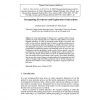Free Online Productivity Tools
i2Speak
i2Symbol
i2OCR
iTex2Img
iWeb2Print
iWeb2Shot
i2Type
iPdf2Split
iPdf2Merge
i2Bopomofo
i2Arabic
i2Style
i2Image
i2PDF
iLatex2Rtf
Sci2ools
104
click to vote
INTERACT
2007
2007
Recognising Erroneous and Exploratory Interactions
A better understanding of “human error” is needed to help overcome problems of people assuming they are to blame for their inability to use poorly designed technology. In order to investigate people's ability to recognize, and reflect on the causes of, particular types of errors, a problem solving environment was designed that allowed participants to verbally self-report erroneous and exploratory interactions. It was found that the pervasiveness of errors was recognizable but underlying cognitive and attentional causes of errors were not. Participants found that providing a causal account of device-specific errors during interaction was especially difficult. A striking feature of device-specific errors is that they involve actions that do not move an individual towards a goal state, but remain critical to performing a task correctly. Successfully identifying why an error has occurred requires an understanding of environmental cues and salience. Findings imply that HCI practiti...
Device-specific Errors | Human Computer Interaction | Human Error | INTERACT 2007 | Problem Solving Environment |
| Added | 29 Oct 2010 |
| Updated | 29 Oct 2010 |
| Type | Conference |
| Year | 2007 |
| Where | INTERACT |
| Authors | Jonathan Back, Ann Blandford, Paul Curzon |
Comments (0)

